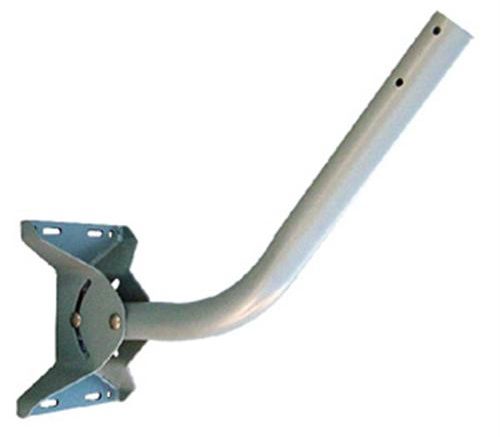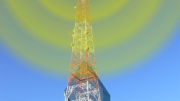Absolutely. There’s only one thing you need to worry about. Let’s take a closer look at the question.
What is a J-Mount?
The image you see above you is a typical “J-Mount.” They’re used for mounting onto a roof or eave, but really you can mount one to pretty much any surface, whether that’s horizontal, vertical, or diagonal, as long as there’s a part of it that’s flat enough to bolt to. Some people even use them on apartment railings with a mixture of U-bolts and zip ties.
J-mounts are among the most flexible mounting systems. You can assemble them like you see above, with the short end closest to the wall. In virtually any J-mount, you can also turn the tube around and put it together the other way, with the long end protruding from the wall. You can mount them on vertical or horizontal surfaces, or even slanted ones like a roof or eave. Using a J-mount all but guarantees that there will be some sort of mounting solution open to you.
What kinds of antennas work with J-mounts
You can mount pretty much any antenna on pretty much any J-mount as long as you can actually clear the roofline or whatever it is you’re mounting to. In other words, the antenna needs to actually fit on the mount and not bump into anything. You’d be surprised how many people don’t think of that when they’re mounting an antenna. Larger antennas like our Xtreme Signal HDB8X antenna actually mount in the middle of the antenna so they need several feet of clearance. In a case like that it’s important to test-fit the mount and antenna before bolting things down.
Depending on the antenna, you may want to choose the largest mount possible. There comes a point where J-mounts are probably not the best bet. I’ve seen them used with oversized antennas like the Xtreme Signal HD8200XL but it’s a bit of a stretch. Depending where you put the mount, the antenna might not fit.
Here are three things to consider
No matter how you attach the J-mount, the end result should be that the antenna you mount to it is perfectly level. That means the end of the mount must be perfectly plumb. Luckily J-mounts are adjustable and you can even make adjustments after the antenna is attached. Just be careful because when you loosen those adjustment bolts, the antenna may flop down. If possible, use two people if you’re going to be adjusting an antenna.
If you’re thinking of mounting to a roof or other flat surface where water could leak in, you should definitely consider a pitch pad like this one which will help keep water from seeping into any holes you drill, and possibly following up with roofer’s tar or any other waterproofing agent. The last thing you want is a roof leak.
If you already have a J-mount on your roof or eave because of an old satellite TV installation, it can usually be used for an antenna install. The round reflector part of the dish usually comes off by loosening the bolts that attach it. Most antennas should fit on a satellite dish’s mount as long as they are able to clear the roof line. Before you start, though, measure the outer diameter of the J-mount. Some satellite dishes use a mount that is too wide for the antenna to fit on. If possible, test fit one of the mounting brackets from the antenna onto the mount before trying to mount the antenna.
Get J-mounts from Solid Signal
Mounting an antenna using a J-mount is easy, and it’s the subject of a classic video from our Solid Signal test team, presented here for your enjoyment.
When you’re ready to get a mount of your own, shop at Solid Signal for everything you’ll need!





